nasa to Unveil New X-59 ‘Quiet’ Supersonic Jet on Jan. 12
NASA and Lockheed Martin are ready to unveil the X-59 Quesst, a supersonic jet designed to break the sound barrier without creating a thunderous sonic boom. The experimental aircraft was under construction at Lockheed Martin’s “Skunk Works” facility in Palmdale, California since 2019, and is set to be revealed on Jan. 12, 4 p.m. EST (2100 GMT). The X-59, also known as Quiet SuperSonic Technology (Quesst) jet, is designed to fly at supersonic speeds and reduce the typical sound of sonic booms. Its unique Design aims to lower the volume of sonic booms to a “thump” similar to the sound of a car door slamming, potentially reshaping regulations barring supersonic flight over populated areas.
Development of the x-59
The X-59 Quesst has been a project of NASA and Lockheed Martin for several years. The aircraft features a sharp, elongated beak-like nose section that measures 38 feet in length. The nose section helps shape the shock waves produced during flight, and the aircraft is equipped with an External Vision System to assist pilots in maneuvering the unique design. Powered by a single engine built by General Electric aviation, the 99.7-foot-long aircraft is designed to reach a speed of Mach 1.4, or 925 mph, at an altitude of 55,000 feet.
Impact on aviation Regulations
The X-59’s design allows it to fly over select residential areas to collect data on how people below experience and react to the quieter sonic booms it creates. NASA plans to use the data to seek approval for commercial supersonic flights from regulatory agencies such as the Federal aviation Administration. This development has the potential to reshape existing regulations that prohibit supersonic flight over populated areas due to the disruptions caused by sonic booms. The project sets a milestone for advancements in supersonic aviation and reduction of its impact on the environment.
Public Engagement and Livestream
As part of the unveiling, NASA will host a free livestream of the X-59 rollout on Jan. 12, accessible via Space.com courtesy of NASA, NASA+, or NASA TV. The agency encourages the public to host watch parties for the rollout, providing printable invites and free STEM toolkits for educators. The livestream offers an opportunity for enthusiasts and educators alike to learn about this breakthrough in supersonic aviation technology.
Future research Campaign and Application
Once ready for flight, the X-59 will conduct a research campaign to collect data on the impact of its quieter sonic booms on residential areas. This data will be instrumental in seeking approval for commercial supersonic flights, potentially revolutionizing air travel by allowing faster flights over populated areas without disrupting daily life. The successful development and application of the X-59 could open new doors for supersonic aviation, marking significant progress in the industry.
Conclusion
The development and unveiling of the X-59 Quesst by NASA and Lockheed Martin represents a major leap forward in supersonic aviation technology. By breaking the sound barrier without generating disruptive sonic booms, the X-59 has the potential to reshape aviation regulations and pave the way for commercial supersonic flights over populated areas. This achievement underscores the commitment to advancements in aviation and demonstrates the innovative capabilities of modern aerospace engineering.
Source: space








No Comments